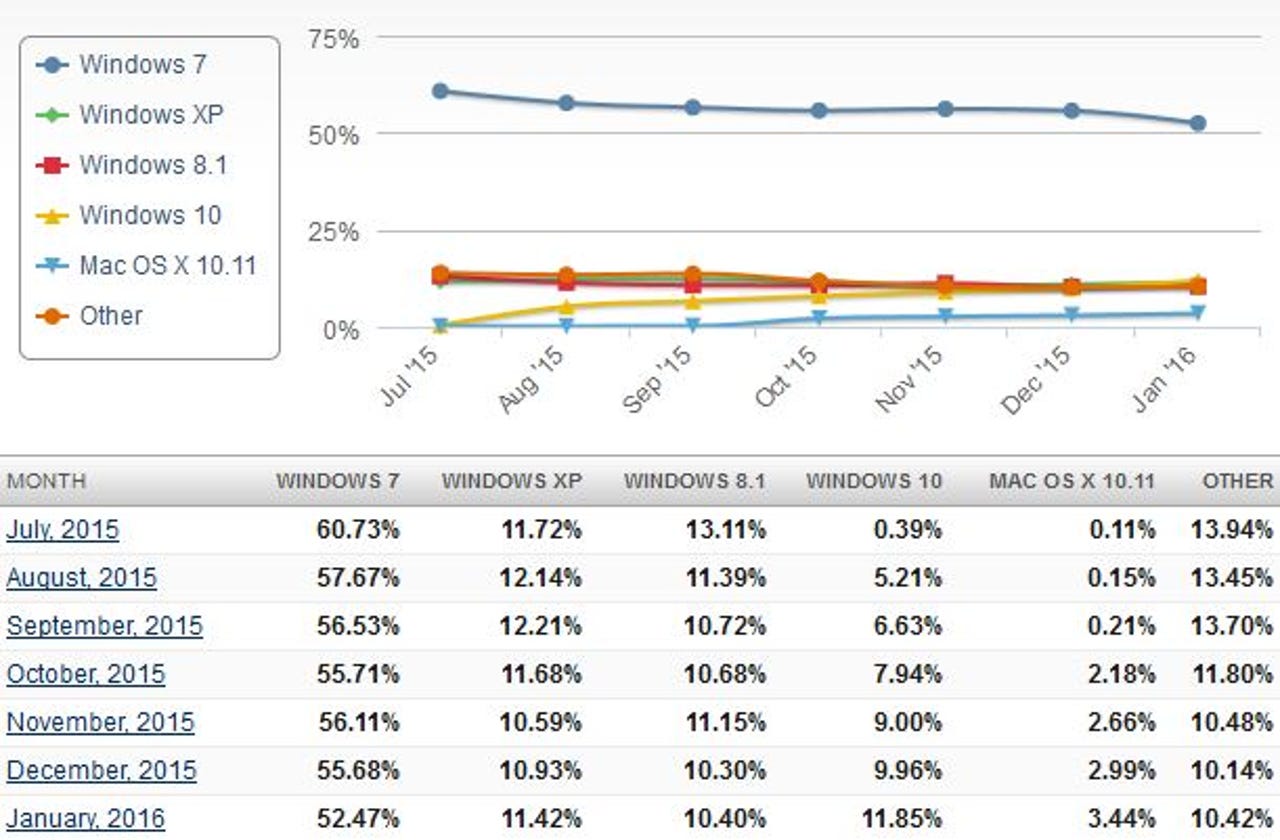Right on cue, Windows 10 has overtaken XP

Netmarketshare's numbers show Windows 10's growth and Windows 7's decline
Whatever happened to all the diehards who were committed to using Windows XP forever? This ancient operating system still has some users, ranging from the British government to pirates in China. However, even on Netmarketshare's figures (above), Windows XP has now been overtaken by Windows 10.
Last year, I posed a question here: How long before Windows 10 overtakes XP - or has it already?
In this post, I noted that: "In ball-park terms, XP has been losing around half a percentage point per month, over the past 12 months. If this trend continues, then Windows 10 could overtake XP in the January numbers, released on February 1, with a score of 11.0 percent vs 10.5 percent."
And so it has come to pass, more or less. Netmarketshare's January numbers put Windows 10 on 11.85 percent and XP on 11.42 percent. Both numbers are probably wrong, but I think the order is correct.
Frankly, I don't believe the XP numbers in particular. According to Netmarketshare, Windows XP hasn't lost any significant market share over the past six months: it had 11.7 percent in July 2015. Inbetween, XP's market share apparently increased to 12.2 percent then sank as low as 10.6 percent before recovering to today's number.
Does anyone think that thousands of people are re-installing XP? It makes more sense to assume that Netmarketshare's polling numbers just aren't that accurate. In other words, the variation is down to the vagaries of counting website usage, rather than real market changes.
What surprises me even more is the decline in Windows 7 users. I expected Windows 8/8.1 users to switch in droves while Windows 7 users committed to using it forever - or at least until 2020. But Netmarketshare's January numbers suggest Windows 7 has dropped 8 percentage points (from 60.7 to 52.5 percent) since Windows 10 was released.
Are the majority of Windows 10 users really Windows 7 switchers? Who predicted that?
Either way, it will be interesting to watch Windows 10's market share numbers over the next six months, now that Microsoft has made it a recommended installation in Windows Update.
Obviously, Windows 10 got off to a good start, thanks to pent-up demand from early adopters. Since then, however, it has shown steady growth on stats from both Netmarketshare and StatCounter (below).
It should be able to maintain or even surpass that growth with Microsoft pushing it harder, and the arrival of more Windows 10 PCs in shops. If all goes well, it could hit 20 percent by the time Microsoft stops offering free upgrades at the end of July.
For the July numbers, published on August 1, I'd regard 25 percent as a spectacular success, and 30 percent as extremely unlikely. But Windows 10 could make 30 percent by Christmas, depending on whether Microsoft offers a good upgrade deal, and the general health of the PC market.
For a fuller run-down on the market shares in the Windows operating system market, see Ed Bott's Windows 10 usage share continues to grow, but enterprise stays on sidelines. This includes numbers from Netmarketshare, StatCounter, and the United States Government's Digital Analytics Program (DAP).
StatCounter's usage-based numbers confirm Windows 10's rise (blue line) and Windows 7's decline....
